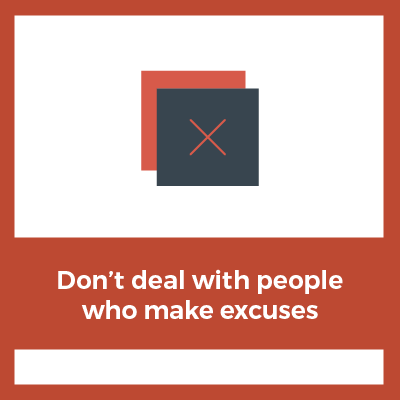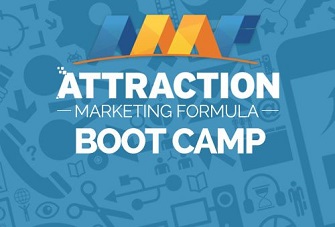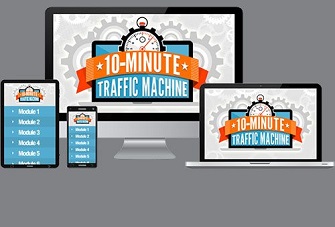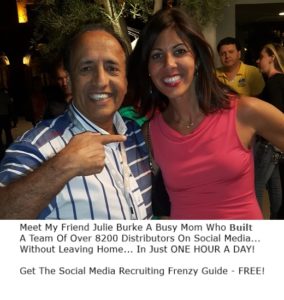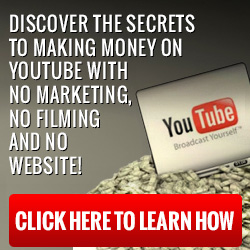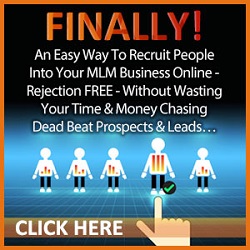On my blog my aim is to constantly bring value to Network Marketers and Entrepreneurs looking to build their business faster using the Internet. I have a policy of publishing articles from authors I value and respect. Today’s guest blog post is from my good friend Andrew Draughon talking about The Five Primary Prospecting and Sales Objections (and How to Gracefully Overcome Them).
Objections come in all shapes, sizes, and colors.
You’ll never be able to prepare yourself for all of them in advance.
The good news is that at their core, there are really only 5 primary objections.
And if you learn them, and the logic for dealing with them, you’ll be able to complete the transaction instead of fumbling your plays mere yards away from the proverbial end zone.
Let’s talk about now.
Like, right now…the present moment.
It’s a mysterious thing, if you think about it—in fact, it’s the ONLY thing.
Because even though they might seem awful real, the past and the future don’t actually exist (outside of your mind).
Not trying to get all philosophical on you; it’s just how things work.
And unfortunately, because we can’t travel backwards or forwards in time, you can’t make a decision yesterday and you also can’t make a decision tomorrow.
…because, you know, you can’t actually do anything in the future, it doesn’t exist (…until it exists, when it becomes the present).
With me so far?
The ONLY time is now!
Unfortunately, the present moment isn’t where your prospects are spending most of their time, energy, and attention.
Instead, a their mind is a maelstrom of thoughts, fantasies, and fears, which typically aren’t directly related to their immediate circumstances.
People get stuck in the past; they worry about the future.
As a result, they are filled with objections.
And, you know what?
That’s not unhealthy or unreasonable.
After all, if we only ever thought of right now, with no regard for the past or future, we’d never learn from our mistakes or anticipate potential outcomes.
Unfortunately, many objections aren’t healthy, as they’re coming from unfounded doubts, fears, misunderstandings, and stress.
And if you’re in sales…
You’re going to need to handle your prospect’s objections
…with skill and grace.
Because overcoming objections is how you make sure the people who need your product get it (and reap its benefits to change their lives for the better).
Here’s the bad news…
Objections come in all shapes, sizes, and colors.
You’ll never be able to prepare yourself for all of them in advance.
The good news is that at their core, there are really only 5 primary objections.
And if you learn the logic for dealing with them, you’ll be able to move your prospect forward, to a decision, instead of fumbling your plays mere yards away from the proverbial end zone.
So without further ado, let’s dive in.
But first, a word about…
Objections vs. Excuses
Objections happen when someone wants what you have—but isn’t ready to commit.
This can happen when…
- You’re not speaking with the primary decision maker
- Because of their past negative experiences
- There’s simply a lack of trust
What matters is that objections can be overcome, because the prospect is interested in your offer.
That’s NOT the story with excuses!
With excuses, the prospect has already decided they don’t actually want what you’ve got.
And they’re just deflecting your offer and quietly hoping you’ll go away.
Of course, a skilled persuader can still overcome excuses and make the sale…
But once the salesman’s gone, the buyer may experience regret, buyer’s remorse, even guilt.
This is not what you want!
Excuses lead to problems down the line, so my best advice is this:
Don’t deal with people who make them.
What you want to do instead is focus on the objections that block easy sales.
This will maximize your efficiency and customer satisfaction (and profits too).
Now, the first common objection you’re likely to deal with is…

Someone once said, “There’s a sucker born every minute.”
It wasn’t P.T. Barnum, though (the origin is unclear).
Regardless, it’s fair to say we’ve ALL felt like suckers at one point or another.
And as a result, everyone develops a healthy sense of skepticism towards anything new and unknown.
The desire to avoid “losing” is so strong customers only buy from people they trust.
That’s why the first objection you’ve got to overcome is skepticism…
The idea that whatever you’ve got simply won’t work as advertised.
A mistake many salespeople make is trying to force the situation.
Instead of figuring out what’s really bothering the prospect, they try to overpower them with phrases like:
- “You won’t regret buying XYZ…”
- “You’re about to make a big mistake…”
- “This will work for you, I guarantee it!”
Newsflash: these rarely work.
The buyer ultimately has all the power in this interaction, which means that trying to push them around is ineffective (and rude).
Another thing that doesn’t work is taking skepticism personally and shutting down the conversation completely.
So what’s the solution?
For starters, figure out what’s the REAL reason the buyer is skeptical and address the problem directly.
- If they’ve been burned before, emphasize your guarantee.
- If they’ve tried similar products with no results, determine what’s causing them to be stuck.
- And if they don’t think it’ll work for them, tell them a success story of someone from a similar position.
Your words won’t always prove that the prospect’s skepticism is unfounded, but they will show that you care—which is key.
One other important thing you mustn’t do is confuse skepticism with the next objection, which is a little similar, yet profoundly different.

The human brain naturally guides us towards comfort and homeostasis…
A low-stress state in which our lives are as constant and predictable as possible.
As a result of this, consumers naturally trend towards complacency in their purchasing habits.
Sure, we like new products and experiences, but we prefer to buy new things from familiar brands.
So what does this mean for you as a salesperson?
Well, it means that people like to do what’s comfortable and familiar.
They don’t want to take any risks, creating a natural resistance to your offer.
Some common fears are:
- Making a premature decision (based on limited information)
- Making the wrong decision
- Losing an opportunity to do something else by choosing your offer
- Losing/replacing something they currently use for your product
Regardless of the specific form the objection takes, the two solutions are universal.
First, you can always pinpoint the fear behind your target’s complacency and help them overcome it (by realizing they want different results in their life).
This way, you defuse the objection in a soft, natural way.
The second option is to make the prospect anxious about losing out on your offer (via a limited time frame, availability, etc.)
Scarcity always works.
This will stimulate the potential customer to take action, helping them overcome their complacency inertia.
Just remember to be ethical when using this second option!
The anxiety you create should be based on real limitations and guide folks towards prudent purchases.
In fact, it’s fair to say that you should never mislead your customers, because your whole business is built on them.
This is true even when you’re dealing with #3; one of the strongest on this list.

Everyone’s got competition.
Even NASA is up against SpaceX, Virgin Galactic, Blue Origin, and a handful of others.
This means that if a prospect is seriously considering your offer, they’re also aware of other, similar offers.
And while that may seem disconcerting at first, it shouldn’t be, because if a client is doing their research, they’re serious about making a purchase.
All you’ve got to do is convince them that your product, and not someone else’s, is what’s best for them.
The best way to do that is by focusing on your competitive advantage.
An excellent framework for doing this is Porter’s Competitive Strategy matrix, which features 3 points:
- Differentiation. In this strategy, you compete by being different, better, or unique—which is how Apple initially carved out a niche in the P.C. market.
- Cost Leadership. Your advantage is in the low price of your product; think Walmart. (This one’s not my favorite.)
- Focus. Your product may not be as cheap or unique as what else is out there, but can be uniquely matched to your prospect’s needs.
The American Association of Retired Persons (AARP), which exclusively focuses on older peoples’ needs, exemplifies this strategy.
Once you figure out which of these 3 best applies to you, simply leverage that advantage to complete the sale.
But before you do, just remember…
Understanding who you’re competing against is key to solving this objection.
You could even ask a question like, “[Name], can we talk about where else you’re looking to solve your [XYZ problem]?”
This will help you figure out their level of market awareness.
Just remember to avoid bombarding the customer with too much information: a mistake that can lead to objection #4.

A recent study of over 4,000 people confirms what we already knew: compared to 40 years ago…
Modern life is significantly more stressful.
Sorry.
It’s fair to say that most people today are rushed and busy.
They’re also constantly being interrupted by ads and marketing materials that aren’t targeted and don’t help matters.
The unfortunate result of this is that consumers become “shut down” and non-responsive to advertising as a self-protection mechanism.
This effect is so strong that young people have learned to almost entirely block ads out nonconsciously!
It’s also why you’re likely to encounter overwhelm as an objection to any sale you try to make.
Customers often feel that they have far too much information to make a decision and move forward.
This objection can take the form of…
- “I don’t have time”
- “I’ve already tried [other product] and it was too confusing and frustrating”
- “I don’t even want to think about learning anything new right now”
- “I don’t know if [product] is right for me and my business”
When this happens, don’t panic.
If the customer is feeling overwhelmed, it’s because they were open at some point and simply got too much information.
This is a positive thing, actually, because it means they are interested in your offer.
The solution, then, is to distill your value proposition into a succinct soundbite expressing a singular benefit.
When you break things down to…
- “This will help you achieve XYZ, in ABC amount of time, without having to QRS or TUV,” or…
- “Here’s how this will will free up X hours a week by eliminating XYZ,” or…
- “You’ll actually get a higher ROI because now you can ABC and 123”
…and other similar points, you leave little room for overwhelm.
You’ve created a concrete, step-by-step vision.
And that leaves us with the final objection, which often shows up alongside the other ones.
What we’re talking about is, of course…

Your customer’s ultimate fear is that they will make a “bad” decision, feel foolish, and experience buyer’s remorse.
This is especially common if you come from a household like mine, where spending money prudently was extremely important!
What makes fear unique as an objection is that, first of all…
Few people will admit to it.
The other thing that makes fear different is that you can’t really remove fear with verbal Jiu-Jitsu or psychological tricks.
Instead, the ultimate way to overcome fear objection is by winning your prospect’s trust and walking them through the entire process.
Give them a tour.
Remove as many unknowns as possible.
Remember: the solution isn’t to push.
This will only lead to dissatisfied customers, returns, and a bad reputation for your business.
Instead, what you want to do is establish productive working relationships that overcome fear and help you make sales again, and again, and again.
Why?
Because…
Relationships, not tricks, make for good business
Okay, so you just learned the 5 biggest sales objections:
- Skepticism,
- Complacency,
- Competition,
- Overwhelm, and
- Fear.
You also learned how to overcome these objections by understanding their root cause.
But, like I’ve mentioned a few times now, unless there’s TRUST between you and your prospect, you won’t be able to bring them to a buying decision.
And in fact, if you appear untrustworthy, the prospect will do everything in their power NOT to think about the decision you’re presenting them.
Instead, they’ll mentally retreat to their past, future, and even imagination to conjure up even more objections.
So, how do you create trust and get folks unstuck?
How do you demonstrate that you can help them improve their results…
No matter how scared they are or how many times they’ve failed in the past?
Well, here’s where things get interesting…
See, the best way to show someone what your product can do…
…is by letting them experience it firsthand.
And unlike brick-and-mortar businesses, which can only give away so many physical samples…
You can easily distribute infinite digital materials like instructional videos, time-saving eBooks, and educational email sequences online.
This type of “freebie” establishes credibility and immediately starts building trust
…long before you’ve ever picked up the phone (or hopped on Skype).
And the best part is this pre-selling process can be completely automated.
In digital marketing, these giveaways are called “lead magnets” because of how fantastic they are at attracting leads.
In fact, you’ve probably seen these “ethical bribes” popping up all over the web, and have likely signed up to one or two newsletters to get the ones that struck your fancy.
It’s a super effective technique for building a list of qualified prospects and warming them up, all before you reach out.
Now, if you’d like to see how we use lead magnets in our advertising process to generate 300–500 hot leads every single day (WITHOUT having to pay for them)…
I’d like to invite you to attend an upcoming training session, hosted by Tim Erway (our co-founder and CEO), where you’ll discover every single element of putting together a riveting advert, constructing a compelling landing page, and crafting an irresistible bribe that converts visitors into leads.
Simply pick a time and register right here.
You’ll see how you can put together a profitable ad campaign in just 10 minutes a day with as little as $10 in initial ad spend.
In fact…
We’ve used this exact formula to turn a $10 test campaign into $141,246.30 in sales.
And Tim will show exactly how we did it.
Once you’ve got this lead generation and pre-selling process in place, you’ll find your prospects have significantly fewer objections because they will implicitly trust you to fulfill their needs and fix their problems!
So if you haven’t registered yet, what are you waiting for?
Pick a time that works for you to attend Tim’s traffic workshop right here.
Until next time.
 Moni Arora’s Blog
Moni Arora’s Blog
Facebook
Linkedin
Twitter
Email Me
 
P.S. If you found value in this blog post please LIKE, COMMENT and SHARE with someone who can benefit from this.
Featured Services To Boost Your Business
Are You A Network
Marketer?
Free 10-Day Online Recruiting Course Shows You How to Recruit – Rejection Free!
Click Here To Learn More!
Learn How To Recruit
Using Social Media!
Create A Massive Recruiting Surge In Your Business With Social Media…
Click Here To Learn More
Do You Want More
Traffic & Leads?
Discover the Simple Method We Used to Produce a 1348% ROI on Our Advertising.
Click Here To Learn More!




